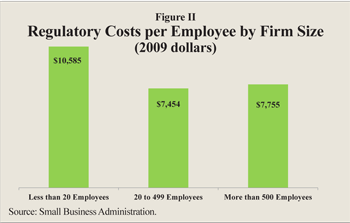The unemployment numbers show that employers are still struggling to create jobs. Two distinctly different approaches to job creation have been proposed at the federal level. One piece of legislation, the Jumpstart Our Business Act (JOBS Act), was recently passed and signed into law.
It should improve small business access to start-up capital by reducing the burden of some federal regulations. Historically, start-up firms have been a major source of new jobs. In contrast, neither house of Congress has passed the American Jobs Act, proposed by the White House more than a year ago. The American Jobs Act would have used $194 billion in additional deficit spending to create jobs — mostly government jobs. The money would have been used for a variety of special items, including hiring new teachers and rehiring laid-off ones, protecting public employees from layoffs, funding additional public infrastructure projects, and renovating public school buildings.
 The JOBS Act versus the American Jobs Act. The JOBS Act relieves qualifying start-up firms of a number of compliance costs. For example, section 404(b) of the Sarbanes-Oxley Act requires an auditor to attest to and report on a company management’s assessment of its internal controls. The JOBS Act exempts a company with up to $1 billion in revenues from 404(b) for the first five years after it makes an initial public offering of stock. This reduces the burden on small start-ups and eases the path to starting new enterprises.
The JOBS Act versus the American Jobs Act. The JOBS Act relieves qualifying start-up firms of a number of compliance costs. For example, section 404(b) of the Sarbanes-Oxley Act requires an auditor to attest to and report on a company management’s assessment of its internal controls. The JOBS Act exempts a company with up to $1 billion in revenues from 404(b) for the first five years after it makes an initial public offering of stock. This reduces the burden on small start-ups and eases the path to starting new enterprises.
The American Jobs Act, by contrast, would have pumped stimulus funds into the public sector. The legislation included requirements that would force states to maintain spending on public schools and colleges at “the same level of support as the previous fiscal year or higher.” This means that states, by accepting additional federal funds under the legislation, would have had to maintain current programs, without the option to reform and reduce spending in order to ease budget pressures.
Small Business Employment and Job-Growing Start-ups. Small businesses are the lifeblood of the U.S. economy. According to the U.S. Small Business Administration:
- There were about six million small- and medium-size companies with fewer than 500 employees in 2008.
- These firms employed about 60 million people; another 21 million people were self-employed.
- Not counting the self-employed, firms with fewer than 20 employees accounted for about 18 percent of total private-sector employment.
Start-ups are usually classified as small businesses, based on employment and revenue. They are also an important source of new jobs. For example, between March 2009 and March 2010, there was a net loss of 1.8 million private sector jobs. However, over that period, 394,000 start-ups created 2.3 million jobs.
Start-ups have declined in recent years, according to a Kauffman Foundation report based on data from the Census Bureau’s Business Dynamics Statistics:
- The number of business start-ups in a given year declined from about 12 percent of all companies in the 1980s to less than 8 percent in 2010, the lowest point on record.
- The share of all businesses that were start-ups within the last five years also declined, from 50 percent in the early 1980s to 35 percent in 2010. [See Figure I.]
To some extent the decline has reversed since 2008, as unemployed workers started new businesses. Many of those businesses are sole proprietorships. However, improved access to capital could encourage existing firms to expand.
 Regulatory Burden on Start-ups and Existing Small Businesses. Small businesses must cope with a variety of regulations and hurdles. Indeed, start-up costs average about $30,000, according to the Kauffman Foundation. Barriers to start-ups can include payroll taxes, minimum wage and employment protection laws, and securities regulations. Payroll taxes in Texas alone, for example, averaged $165 per worker per year before payroll taxes were reduced in 2011, according to the U.S. Labor Department and state workforce agencies.
Regulatory Burden on Start-ups and Existing Small Businesses. Small businesses must cope with a variety of regulations and hurdles. Indeed, start-up costs average about $30,000, according to the Kauffman Foundation. Barriers to start-ups can include payroll taxes, minimum wage and employment protection laws, and securities regulations. Payroll taxes in Texas alone, for example, averaged $165 per worker per year before payroll taxes were reduced in 2011, according to the U.S. Labor Department and state workforce agencies.
The cost of hiring an employee can also be prohibitive. Consider, the average cost of hiring an $8.00 an hour employee is between $5,500 and $9,500, according to the Sasha Corporation, a human resources consulting firm.
The costs are even higher if one looks at the larger regulatory picture. [See Figure II.] The U.S. Small Business Administration reports that in 2008 small businesses faced annual regulatory costs of $10,585 per employee, compared to $7,454 for medium-size firms with 20 to 499 employees. Regulatory costs for firms with 500 or more employees were only slightly higher than medium size firms, at $7,755 per employee. These costs include a variety of regulations — environmental, economic, occupational, homeland security and tax compliance.
The relative cost faced by small firms is indicative of how significant a burden they face:
- In 2008, regulatory costs per employee for small firms with fewer than 20 employees were 36 percent greater per employee than firms with more than 500 employees.
- The regulatory cost for small firms was 42 percent greater than for medium-size firms with 20 to 499 employees.
Unburdening Small Business. Regulations can be particularly burdensome to small businesses in comparison to large ones, because the fixed costs associated with regulatory compliance are spread over less revenue and fewer employees. Competition and uncertainty are also challenging for smaller enterprises. Large firms are better insulated against international competition, as many of them can relocate their enterprises to other countries to escape U.S. regulations. When faced with uncertainty, larger firms are more likely and are better able to analyze and predict the scale, scope and impact of new regulations.
Conclusion. By extending deadlines before small companies have to comply with certain financial regulations, the JOBS Act allows start-ups to hire more people and attract more capital from investors. Furthermore, this bipartisan piece of legislation will cost taxpayers nothing.
Brian Bodine is a graduate student fellow with the National Center for Policy Analysis.